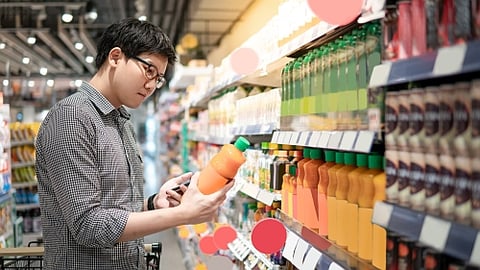10 Ways Supermarket and Grocery Retailers Can Use Augmented Reality
In part one of this two-part series, we aimed to inspire you with ideas and examples of how augmented reality can be used to improve key aspects of the retail customer experience, increase brand loyalty and achieve real business value inside your stores. Now let’s look at the vast potential augmented reality has to achieve real business goals outside your stores.
6. Reach Massive Audiences — Organically — With Social AR
Social networks such as Snapchat, Instagram and TikTok want to accelerate user adoption of augmented reality (AR) and are pulling out all the stops to do so.
In fact, anecdotal evidence suggests their algorithms currently favor AR content, giving it outsized organic reach. Furthermore, AR content lends itself extremely well to sharing, which offers built-in virality to grocery brands that create smart AR experiences.
According to a recent report by Camera IQ, 78% of consumers say that they’re likely to share a brand’s AR experience on social media, and more than four out of 10 say that they’re more likely to share an AR experience than other types of brand posts.
Why pay to promote a static ad when your brand could experience arguably better social growth free and organically?
If your brand has a decent following on one of these social networks, creating social AR content is sort of a no-brainer, as it will likely pay for itself. Also, if you’re looking to jump onto a new platform, social AR content is a fantastic way to quickly grow your account. Of course, these algorithms won’t always favor AR content, which is why the time is right to dive in and run some social AR experiments.
7. Gain Presence and Mindshare Inside Grocery Customers’ Homes With AR Experiences
Unless we’re preparing to go to the supermarket or unpacking groceries after returning home, we mostly think about the food itself when we’re in our kitchen, not the grocery store. But what if grocery stores used interactive AR recipes as a way to help us turn the food we’ve purchased into delicious meals throughout the week?
Food brands are already very close to doing this. Take Unilever brand Knorr for example, which recently began printing QR codes on packaging that led consumers to AR recipe experiences.
Why not continue these types of experiences within your customers’ homes to bring recipes of all kinds to life and make your grocery brand top of mind throughout the week?
8. Take Grocery Event Sponsorships to Next Level With AR Experiences
Grocery event sponsorships typically take the form of signage at sporting events, a mascot in a costume, giveaways and the like. We’ve all seen that before. However, Kroger recently unveiled a televised augmented-reality sponsorship with the Houston Texans that no one had seen before — an interactive fan-driven racing game — and the crowd absolutely loved it.
Imagine how much fun the crowd would have if your mascot took over a stadium like a friendly Stay-Puft Marshmallow Man, or if giant fruits and vegetables came to life to play interactive games with the audience. How many people would share videos of the experience on social media?
9. Increase Grocery Beauty Sales With Virtual Try-On
Today, nearly half (49%) of consumers purchase more beauty products online than they did prior to COVID-19, according to a PowerReviews survey of more than 11,000 U.S. shoppers. Furthermore, a recent report from FMI - The Food Industry Association notes that 41% of surveyed shoppers are more likely to purchase store brands amid rising grocery inflation.
According to SPINS: “Shoppers are quick to notice price changes and find ways to maximize their paychecks. They eat more meals at home, comparison-shop between stores and brands, consider private label options, and look online and in-store before making a purchase.”
Given this backdrop, how many of your monthly website visitors would be curious enough to click on an AR virtual try-on experience, particularly from a reasonably priced brand?
As of 2017, just 2% of women in the United States purchased their beauty products from a grocery store, according to Statista. The world has changed dramatically since then, however, and current conditions could provide an opportunity to shift more beauty and personal care purchases to the grocery store — with the right approach.
Augmented reality provides a path for grocery retailers to secure a bigger share of the $93.1 billion U.S. beauty and personal care market, and to keep pace with national beauty brands that already offer such experiences.
10. Drive Product Discovery and Bring Shoppers to Your Website with AR Advertising
Online grocery shopping boomed during the pandemic and shows no signs of slowing. According to Insider Intelligence, digital grocery buyers account for more than half of the U.S. population, and U.S. digital grocery sales will grow another 20.5% this year, reaching $147.51 billion.
In an attempt to increase its already outsize share of the digital grocery and e-commerce markets, Walmart recently partnered with Meta to test augmented-reality ads with 3D view on Facebook and found that they led to stronger lifts in website traffic (2.2%) versus the retailer’s business-as-usual video link ads (0.6%). Furthermore, shoppers spent 10 times more time with augmented-reality advertising than with business-as-usual ads.
The Grocery AR Opportunity Has Officially Arrived
The potential of augmented reality to deliver bottom-line business results for grocery and supermarket retailers is truly remarkable. In fact, augmented reality may turn out to be the most significant advancement to hit the grocery industry in decades. As both competition and opportunity in the AR space heats up among national brands and grocery chains, the time is ripe to seize upon augmented reality as a competitive differentiator.
You can start by creating an AR strategy with your team, experimenting to discover what works best for your customers, and sourcing advertising and digital experience production partners to help you create engaging AR experiences both inside and outside of your stores.








